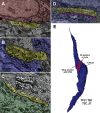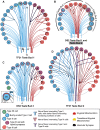Taste Bud Connectome: Implications for Taste Information Processing
- PMID: 34876471
- PMCID: PMC8808728
- DOI: 10.1523/JNEUROSCI.0838-21.2021
Taste Bud Connectome: Implications for Taste Information Processing
Abstract
Taste buds contain multiple cell types, two of which mediate transduction of specific taste qualities: Type III cells transduce sour while Type II cells transduce either sweet, or bitter or umami. In order to discern the degree of interaction between different cell types and specificity of connectivity with the afferent nerve fibers (NFs), we employed serial blockface scanning electron microscopy (sbfSEM) through five circumvallate mouse taste buds. Points of contact between Type II and Type III cells are rare and lack morphologically identifiable synapses, suggesting that interaction between these cell types does not occur via synapses. Of the 127 NFs that make synaptic contacts with taste cells in the sampling volume, ∼70% (n = 91) synapse with only one taste cell while 32 fibers synapse exclusively with multiple Type II cells or multiple Type III cells. Our data do not rule out multimodal fibers innervating Type II cells of separate taste qualities. Notably, four fibers (∼3%) synapse with both Type II and Type III cells, forming both mitochondrial and vesicular synapses on the different cell types. Since Type II and Type III cells transduce different taste qualities, these dual connected fibers are not consistent with a absolute labeled-line encoding system. Further, our data reveal considerable variation in both the number of synapses per cell/nerve pair and the number of innervating NFs per taste cell, both of which likely have consequences for encoding taste quality and concentration. Finally, we identify a subset of Type II cells which may represent an immature stage.SIGNIFICANCE STATEMENT Taste buds, the sensory end organs for the sense of taste, contain multiple types of sensory cells, with each responding to one of the primary tastes: salt, sweet, sour, bitter, and umami. In order to determine the degree of interaction between cell types and specificity of connectivity to afferent nerves, we employed serial blockface electron microscopy (EM) of mouse circumvallate taste buds. We find no synapses between cell types within the taste bud suggesting that any interactions are indirect. While the majority of nerve fibers (NFs) connect to a single type of taste cell, 3.1% of the fibers branch to receive input from taste cells of different specificities. Thus, taste cannot entirely be carried along NFs dedicated to single taste qualities.
Keywords: CALHM1; electron microscopy; labeled line; nerve fibers; synapse; taste buds.
Copyright © 2022 the authors.
Conflict of interest statement
The authors declare no competing financial interests.
Figures










Similar articles
-
Ultrastructure of mouse vallate taste buds: III. Patterns of synaptic connectivity.J Comp Neurol. 1988 Apr 1;270(1):1-10, 56-7. doi: 10.1002/cne.902700102. J Comp Neurol. 1988. PMID: 3372731
-
Three-dimensional reconstructions of mouse circumvallate taste buds using serial blockface scanning electron microscopy: I. Cell types and the apical region of the taste bud.J Comp Neurol. 2020 Apr 1;528(5):756-771. doi: 10.1002/cne.24779. Epub 2019 Nov 1. J Comp Neurol. 2020. PMID: 31587284 Free PMC article.
-
Application of serial sectioning and three-dimensional reconstruction to the study of taste bud ultrastructure and organization.Microsc Res Tech. 1994 Dec 1;29(5):381-407. doi: 10.1002/jemt.1070290508. Microsc Res Tech. 1994. PMID: 7858318
-
Signal transduction and information processing in mammalian taste buds.Pflugers Arch. 2007 Aug;454(5):759-76. doi: 10.1007/s00424-007-0247-x. Epub 2007 Apr 28. Pflugers Arch. 2007. PMID: 17468883 Free PMC article. Review.
-
The microphysiology of peripheral taste organs.J Neurosci. 1992 Apr;12(4):1127-34. doi: 10.1523/JNEUROSCI.12-04-01127.1992. J Neurosci. 1992. PMID: 1348270 Free PMC article. Review.
Cited by
-
Epitope Tagging with Genome Editing in Mice Reveals That the Proton Channel OTOP1 Is Apically Localized and Not Restricted to Type III "Sour" Taste Receptor Cells.J Neurosci. 2025 Feb 5;45(6):e1560242024. doi: 10.1523/JNEUROSCI.1560-24.2024. J Neurosci. 2025. PMID: 39592233 Free PMC article.
-
Neuroscience of taste: unlocking the human taste code.BMC Neurosci. 2024 Mar 21;25(1):19. doi: 10.1186/s12868-024-00847-2. BMC Neurosci. 2024. PMID: 38515045 Free PMC article. Review.
-
Death in the taste bud: engulfment of dying taste receptor cells by glial-like Type I cells.bioRxiv [Preprint]. 2024 Dec 2:2024.09.06.611711. doi: 10.1101/2024.09.06.611711. bioRxiv. 2024. Update in: Glia. 2025 Aug;73(8):1660-1672. doi: 10.1002/glia.70025. PMID: 39314340 Free PMC article. Updated. Preprint.
-
Volume electron microscopy.Nat Rev Methods Primers. 2022 Jul 7;2:51. doi: 10.1038/s43586-022-00131-9. Nat Rev Methods Primers. 2022. PMID: 37409324 Free PMC article.
-
Taste arbor structural variability analyzed across taste regions.J Comp Neurol. 2023 May;531(7):743-758. doi: 10.1002/cne.25459. Epub 2023 Feb 5. J Comp Neurol. 2023. PMID: 36740741 Free PMC article.
References
Publication types
MeSH terms
Grants and funding
LinkOut - more resources
Full Text Sources
